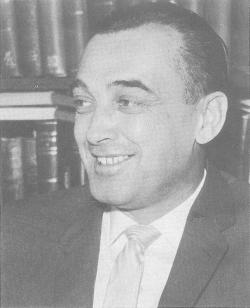
A. E. van Vogt
Named a Grand Master in 1995
Alfred Elton van Vogt (April 26, 1912 – January 26, 2000) was a Canadian-born science fiction author regarded as one of the most popular, influential and complex science fiction writers of the mid-twentieth century: the “Golden Age” of the genre.
In 1996, van Vogt received a Special Award from the World Science Fiction Convention “for six decades of golden age science fiction.” That same year, the Science Fiction and Fantasy Hall of Fame inducted him in its inaugural class of two deceased and two living persons, along with writer Jack Williamson (also living) and editors Hugo Gernsback and John W. Campbell.
The works of van Vogt were translated into French by the surrealist Boris Vian (The World of Null-A as Le Monde des Å in 1958), and van Vogt’s works were “viewed as great literature of the surrealist school.”
After starting his writing career by writing for “true confession” style pulp magazines like True Story, van Vogt decided to switch to writing something he enjoyed, science fiction. This happened after he casually picked up the August 1938 issue of Astounding Science Fiction from a newsstand, and found the story “Who Goes There?” The story inspired him to write “Vault of the Beast,” which he would send to the same magazine. It was rejected, but the rejection letter encouraged him to try again. He would then send in a new story called “The Black Destroyer,” which was accepted, while a rewritten version of “Vault of the Beast” would be published in 1940.
Van Vogt’s first SF publication was inspired by The Voyage of the Beagle by Charles Darwin. “The Black Destroyer” was published by John W. Campbell in Astounding Science Fiction, July 1939, the centennial year of Darwin’s journal. It featured a fierce, carnivorous alien, the coeurl, stalking the crew of an exploration spaceship. The second Space Beagle story appeared in December, “Discord in Scarlet.” Van Vogt’s first completed novel, and one of his most famous, is Slan (Arkham House, 1946), which Campbell serialized in Astounding September to December 1940. Using what became one of van Vogt’s recurring themes, it told the story of a 9-year-old superman living in a world in which his kind are slain by Homo sapiens.
In 1941, van Vogt decided to become a full-time writer, quitting his job at the Canadian Department of National Defence. Extremely prolific for a few years, van Vogt wrote a large number of short stories. In the 1950s, many of them were retrospectively patched together into novels, or “fixups” as he called them, a term which entered the vocabulary of science fiction criticism. When the original stories were related (e.g., The War against the Rull) this was often successful. When not (e.g., Quest for the Future) the disparate stories thrown together generally made for a less coherent plot.
